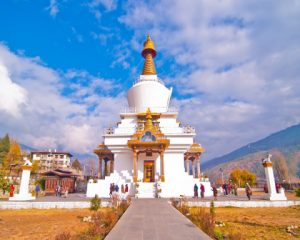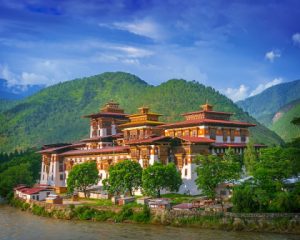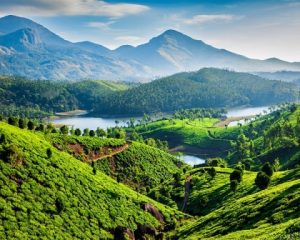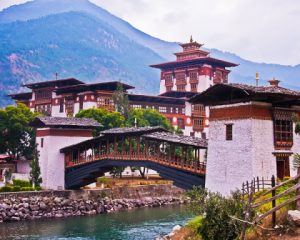Incredible Bhutan
Starting price :
$2725
Duration :
6 Nights / 7 Days
Start city :
Thimphu
Welcome to the happy country of Bhutan! Lets explore the serene landscapes, ancient monastries, lush valleys and quaint towns dotted with colorful Buddhist prayer flags. All this topped with a warm dose of happy locals that makes Bhutan, the perfect destination to travel, explore & celebrate life!
- Explore 3 amazing cities of the happy country.
- Visit Tiger’s Nest Monastery in Paro.
- Thimphu, Bhutan’s capital, uniquely blends tradition and modernity, featuring landmarks like the Tashichho Dzong and the towering Buddha Dordenma statue.
- Witness the benevolent ‘Buddha Dordenma’ statue.
- Cross the scenic Dochula Pass & view 108 Chortens.
- Punakha Dzong – Palace of Great Happiness or Bliss.
Itinerary
Day 1: Arrival in Paro - Thimphu (50 Kms. / Approx. 02 Hrs. Drive)
Arrive at Paro International Airport. Paro is situated in a beautiful valley at 2280 metres and is a fitting introduction to this charming kingdom. Your guide will meet you and take you on a short one-hour drive along the Paro and Thimphu river valleys to Thimphu, Bhutan’s capital, at 2320 metres. You can stop on the way to take in the magnificent Tamchhog Lhakhang, the hereditary place of worship for Bhutan’s iron bridge builder. Take a late afternoon walk around town and soak in the atmosphere of this magical capital with its busy shops and bazaars and photogenic citizens in national dress.
In the afternoon, visit Trashichhoedzong, “fortress of the glorious religion”.
This is the center of government and religion, site of monarch’s throne room and seat of Je Khenpo or Chief Abbot. Built in 1641 by the political and religious unifier of Bhutan, Shabdrung Ngawang Namgyal, it was reconstructed in 1960s in traditional Bhutanese manner, without nails or architectural plans.
Overnight :
Thimphu
Day 2: Thimphu Sightseeing
 This day after your breakfast visit the revered Memorial Chorten, the huge statue of Buddha Dordenma, which commands a tremendous view of Thimphu valley. The huge 3-storey throne holds several chapels and the body itself is filled with 125,000 smaller statues of Buddha. Then visit the Simply Bhutan, National Library, and the School of Traditional Arts and Folk Heritage Museum.
This day after your breakfast visit the revered Memorial Chorten, the huge statue of Buddha Dordenma, which commands a tremendous view of Thimphu valley. The huge 3-storey throne holds several chapels and the body itself is filled with 125,000 smaller statues of Buddha. Then visit the Simply Bhutan, National Library, and the School of Traditional Arts and Folk Heritage Museum.
In the afternoon, visit the Takin Reserve showcasing the unique national animal, the Takin, BBS Tower and Nunnery. Browse the striking collection of intricate textiles at the National Textile Museum. Then visit the newly opened postal museum, detailing the history of Bhutan’s postal system and showcasing Bhutan’s rich assortment of interesting stamps. Visit the Jungshi Handmade Paper factory, which produces traditional Bhutanese paper from the daphne bush. Later visit Tashichho Dzong, built in 1641, which housed the original National Assembly and is now home to Government offices, the throne room and offices of the King. If you would like to view or buy Bhutanese handicrafts you may like to visit the new market opposite Taj Tashi hotel which has an array of stalls run by local handicraft shops selling purely homemade articles with no imports.
Overnight : Thimphu
Day 3: Cochin - Munnar (125 Kms / Approx 04 Hrs. Drive)
 This day after your breakfast check out from your hotel and drive to Punakha via Dochula Pass.
This day after your breakfast check out from your hotel and drive to Punakha via Dochula Pass.
The walk is really impressive as it zigzags up to the 3,140 m high Dochula Pass, through a forest of waving prayer flags and a labyrinth of commemorative cliffs and on clear days, panoramic views of the main Himalayan range. At the top of this mountain pass overlooking the Himalayas, there is a concentration of 108 chortens (stupas) built in memory of the Bhutanese soldiers killed in the 2003 war. The Queen Mother, Ashi Dorji Wangmo Wangchuck, commissioned the monument after that King Jigme Singye Wangchuck was victorious in the struggle to dislodge the rebels who used Bhutan as a base to attack India. Stop at the Dochula Pass, which offers an impressive 360-degree panoramic view of the Himalayas. The view is especially picturesque on clear winter days with snow-capped mountains forming a majestic backdrop to the tranquility of the 108 chortens adorning the mountain pass.
Continue drive to Punakha.
Punakha served as the capital of Bhutan until and still it is the winter seat of Je Khenpo (the chief abbot). Blessed with temperate climate and owing to its natural drainage from Pho Chhu (male) and Mo Chhu (female) rivers, the Punakha valley produces abundant crops and fruits.
Later, visit Punakha Dzong
Punakha Dzong or (Palace of Great Happiness), it was built at the junction of the Phochu and Mochu rivers in 1637 by Shabdrung Ngawang Namgyal. This majestic dzong served as both the religious and the administrative center of Bhutan in the past. It measures some 600 by 240 feet and has a six-story, gold-domed tower. Inside are courtyards and religious statuary that hint at the depth of history and spiritual tradition embodied here. Your guide will illuminate your understanding of this intricate culture that is exotic to us, though long established here.
Overnight : Punakha
Day 4: Punakha Sightseeing
 This day after your breakfast enjoy small hike to Chimi Lhakhang.
This day after your breakfast enjoy small hike to Chimi Lhakhang.
The Chimi Lhakhang, situated on a hillock in the center of the valley, is dedicated to Lama Drukpa Kuenley, who in the late 15thcentury used humor, songs and outrageous behavior to dramatize his teachings and due to this also known as "Divine Madman". This temple is also known as the temple of fertility. It is widely believed that couples who do not have children and wanting one, if they pray at this temple, they are usually blessed with a child very soon. It is about 30 minute walk across field from the road to the temple. The trail leads across rice fields to the tiny settlement of Pana, meaning "field". It then follows a tiny stream downhill to Yoaka and across more fields before making a short climb to Chimi Lhakhang.
In the afternoon, visit Sangchhen Dorji Lhuendrup Lhakhang Nunnery.
Perched on a ridge amid pine trees and overlooking valleys of Punakha and Wangduephodrang, gleams the magnificent structures of Sangchhen Dorji Lhuendrup Lhakhang (Temple). The temple houses a 14-foot main bronze statue of Avalokiteshvara (Chen Rig Zig Chag Tong Chen Tong).
Other statues include those of Guru Padmasambawa, Gautama Buddha, Zhabdrung Ngawang Namgyel, Tsela Namsum, the 21 Taras and Tsepamay (Buddha of longevity). The Avalokiteshvara statue, one of the biggest in the country, was the handiwork of entirely local Bhutanese artisans.The temple complex also houses a permanent higher learning and meditation centre for nuns where, apart from religious trainings, it provides life skill training such as tailoring, embroidery, statue making and thangka painting.
Overnight : Punakha
Day 5: Punakha - Paro (140 Kms. / Approx. 04 Hrs. Drive)
 This day after your breakfast check out from your hotel and drive back to Paro.
This day after your breakfast check out from your hotel and drive back to Paro.
The beautiful valley of Paro encapsulates within itself a rich culture, scenic beauty and hundreds of myths and legends. It is home to many of Bhutan's oldest temples and monasteries, National Museum and country's only airport. Mount. Chomolhari (7,314m) reigns in white glory at the northern end of the valley and its glacial water plunge through deep gorges to form Pa Chhu (Paro River). Paro is also one of the most fertile valley in the Kingdom producing a bulk of the locally famous red rice from its terraced fields.
In the afternoon, walk down the trail (10 min walk) to visit Rinpung Dzong, meaning (“fortress of the heap of jewels”), which has a long and fascinating history. Built in 1646 by Shabdrung Ngawang Namgyal, the first spiritual and temporal ruler of Bhutan, the Dzong houses the monastic body of Paro, the office of the Dzongda (district administrative head) and Thrimpon (judge) of Paro district. The approach to the Dzong is through a traditional covered bridge called Nemi Zam. A walk through the bridge, over a stone inlaid path, offers a good view of the architectural wonder of the Dzong as well as life around it. It is also the venue of ParoTshechu, held once a year in the spring.
Later proceed to visit Ta Dzong, originally built as Watchtower, which now houses National Museum. The extensive collection includes antique thangkha paintings, textiles, weapons &armor, household objects and a rich assortment of natural and historic artifacts.
Overnight : Paro
For more details Contact Us
For more details Contact Us
Inclusions
- Accommodation with breakfast for 06 Nights.
- English speaking guide for sightseeing.
- A bottle of water per person, every day during your Tour.
- All sightseeing and transfer by private air conditioned vehicle as per the itinerary.
- All Assistance by Colourful Asia representatives on arrival & departure.
- All applicable government tax, toll tax, parking, interstate tax, etc.
Exclusions
- International or domestic fights.
- Entrance Fees to monuments/sightseeing places.
- Any Personal Expenses.
- Any other services which are not mentioned above.
Spotlight Of Tour
Duration : 6 Nights / 7 Days
Starting price : $2725 Per Person
Route : Paro – Thimphu – Punakha – Paro
